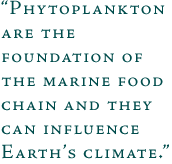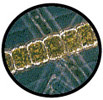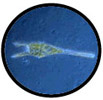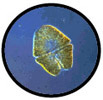
 |
||
|
|
||
|
by David Herring Phytoplankton are microscopic plants that live in the ocean. There are many species of phytoplankton, each of which has a characteristicshape. Collectively, phytoplankton grow abundantly in oceans around the world and are the foundation of the marine food chain. Small fish, and some species of whales, eat them as food. Larger fish then eat the smaller fish. Humans catch and eat many of these larger fish. Since phytoplankton depend upon certain conditions for growth, they are a good indicator of change in their environment. For these reasons, and because they also exert a global-scale influence on climate, phytoplankton are of primary interest to oceanographers and Earth scientists around the world. |
 |
||


 |
Different species of phytoplankton come in many different shapes and
sizes. But they all get their green color from chlorophyll, the pigment
they use during photosynthesis. (Left photo courtesy of the SeaWiFS
Project. Center and right photos courtesy of D.W. Coats.)
|
||
|
The life and death of phytoplankton
Like their land-based relatives, phytoplankton require sunlight, water, and nutrients for growth. Because sunlight is most abundant at and near the sea surface, phytoplankton remain at or near the surface. Also like terrestrial plants, phytoplankton contain the pigment chlorophyll, which gives them their greenish color. Chlorophyll is used by plants for photosynthesis, in which sunlight is used as an energy source to fuse water molecules and carbon dioxide into carbohydrates—plant food. Phytoplankton (and land plants) use carbohydrates as "building blocks" to grow; fish and humans consume plants to get these same carbohydrates. |
What are Phytoplankton?
The life and death of phytoplankton How do phytoplankton influence global climate? What is a coccolithophore? Related Data Sets
|
||
|
The atmosphere is a rich source of carbon dioxide, as millions of tons of this gas settle into the ocean every year. However, phytoplankton still require other nutrients, such as iron, to survive. When surface waters are cold, deeper depths are allowed to upwell, bringing these essential nutrients toward the surface where the phytoplankton may use them. However, when surface waters are warm (as during an El Niño), they do not allow the colder, deeper currents to upwell and effectively block the flow of life-sustaining nutrients. As phytoplankton starve, so too do the fish and mammals that depend upon them for food. Even in ideal conditions an individual phytoplankton only lives for about a day or two. When it dies, it sinks to the bottom. Consequently, over geological time, the ocean has become the primary storage sink for atmospheric carbon dioxide. About 90 percent of the world's total carbon content has settled to the bottom of the ocean, primarily in the form of dead biomass. |
The cartoon animation to the left shows how phytoplankton use sunlight and carbon dioxide to make food and grow. When they die, their microscopic bodies settle to the bottom, thus storing vast amounts of carbon there over geological time. (Courtesy of Barbara Summey, Goddard SVS) (2.1MB) | ||
|
Subscribe to the Earth Observatory About the Earth Observatory Contact Us Privacy Policy and Important Notices Responsible NASA Official: Lorraine A. Remer Webmaster: Goran Halusa We're a part of the Science Mission Directorate |
|
|